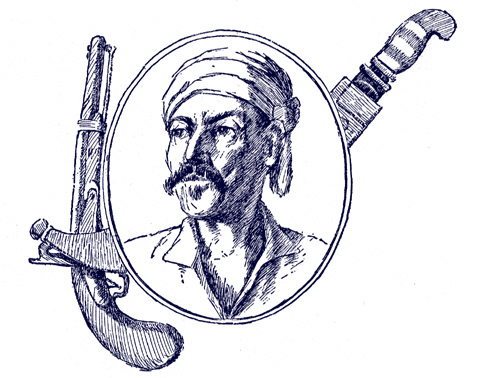Old Print Article: “Texas Treasure Seekers,” New York Times (1893)
October 11, 2013 in Old Print Articles, Urban Studies | Permalink
Like a lot of pirates, Jean Lafitte supposedly buried great treasures that were just waiting patiently beneath the earth to be struck with a shovel. Those with dubious maps and those with just a hunch went in search of such interred wealth in the nineteenth century, including a trio of enterprising Texans featured in a politically incorrect article in the August 3, 1898 New York Times. The story:
“Galvreston, Texas–For many years there have been traditions that Lafitte, the buccaneer, had left vast sums of gold coin and silver bars buried about Galveston Island previously to his having been ordered away by the United States Government. From time to time persons have dug on the island and mainland in search of this treasure, and their utter failure appears to have in no way prevented others from making the attempt.
Twelve miles ‘down the island’ to the west of the city is a small clump of live-oak trees, situated on the line of the Galveston and the Western Railroad, which is commonly called Lafitte’s Grove. History has handed down the fact that these trees were the favorite camping ground of the Caranchua a savage tribe–said to be cannibals–of magnificently proportioned warriors one roaming over the mainland and crossing to Galveston Island across the shallows still bearing the name of Caranchua Reefs. There they would have great oyster roasts, procuring the succulent bivalve from the natural reefs along the shore of the bay; and the huge piles of shells still remaining attest the fact that their appetites were good.
Here tradition has it that Lafitte attacked these savages for the murder of one of his men, and after a severe conflict defeated them with heavy loss, a number of his won men being slain in the battle.
Having consulted an old man with a divining rod, who made an examination of the land near Lafitte’s Grove, and who positively asserted that there was buried treasure in the neighborhood, Frank Corbin, John Geen, and William Irvine of this place concluded that the spot where Lafitte had ‘planted’ his loot had been located at last, and secured permission from Capt. M.A. Baro, the owner of the land, to dig there, it being stipulated that he was to receive 35 percent of the value of the find.
The prospectors began operations about a week ago, and prosecuted work vigorously until to-day, excavating about twenty large holes in different spots in the vicinity of the trees, but they failed to discover anything of value. They, however, unearthed the skulls and bones of a number of large men, supposed to be the remains of the Caranchua warriors who perished in the battle with Lafitte’s men, as well as a number of flint arrowheads and tomahawks.
The party is not at all discouraged, and says that it will shortly resume perations at another point.”
Tags: Capt. M.A. Baro, Frank Corbin, Jean Lafitte, John Geen, William Irvine
Subscribe to my free Substack newsletter, "Books I Read This Month." It's published on the final day of each month. Some new titles, some older, some rare.
Categories
About
Afflictor.com is the website of Darren D’Addario. Except where otherwise noted, all writing is his copyrighted material. ©2009-18.

